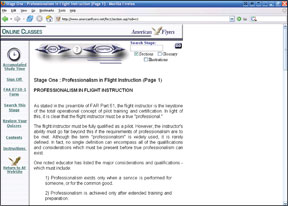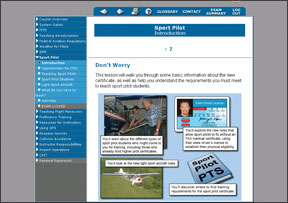Heres a surprising statistic: Of the just under 600,000 pilots listed on the FAAs records 90,000-or about one in six-are flight instructors. How many actually actively teach? Probably under 50 percent, but instructor certificates are perishable items and the poor slugs who own them must renew them every 24 months. There are various ways to do this, but the most popular seems to be the flight instructor refresher clinic, or FIRC. For decades, these courses meant a three-day weekend sitting in a stuffy conference room with a bunch of other renewing CFIs in a ritual butt-numbing marathon. The dawn of the internet brought the option of grinding through 16 hours of online training sitting alone in front of a computer. All the drudgery without the camaraderie. Aint technology grand? But 191 are these courses any good? Are they even tolerable? We looked at courses offered by American Flyers, Gleim Publications and a collaboration between Jeppesen and AOPA. Each approaches the online challenge differently, but they can be compared in three key areas: content, organization and price.
Words or Pix?
According to American Flyers vice-president David Hugheser, Flyers strategy was to take the content of their weekend course and put it on line. Simple. Unfortunately, the FAR review that works fine with a dynamic teacher can be torture via the Web.
The AF course is page after page of text, with the occasional link to a graphic or rudimentary animation. A couple of times, a link takes you to a tiny, digitized version of a dated FAA training video. Theyre just as somniferous online as they are in a darkened classroom, but now theyre hard to see, too.
The text varies from verbatim FARs and Advisory Circulars to something more akin to a textbook. Occasionally, the course becomes opinionated-and much more entertaining. We admit there’s value to exhaustive review of the FARs or Fundamentals of Instruction, but no one would call it fun. The Flyers course is only for the self-motivated. “Weve had guys who want a refund because its too hard,” says Hugheser. “They fail the first two quizzes. They don’t want to work that hard. I can understand that. If I had a choice, Id rather sit through a class.”
We were disappointed in the presentation of the content. The course consists of six modules, but they vary in size. Some take as little as an hour to complete; some are supposed to take over four. The time is important as you must be logged in for at least that long before youre allowed to take the test for that module. Individual pages vary in length from a short screen to a long scrolling page, but we found the text oddly formatted, which makes reading it more challenging.
The course is inconsistent about where things are emphasized or explained, in our view, but where it does emphasize or summarize, it does a good job. In a few cases, the linked images -in higher resolution for detailed study- were of too poor quality to be useful. The pages contain links to other Web sites for additional information. Flyers says theyre reviewing the course and creating new, more

interactive content. We assume this will fix formatting inconsistencies.
GLEIM
The Gleim Aviation FIRC covers much of the same content, but breaks it up into 16 lessons of relatively equal length. They also start each lesson with a 20-question, true-or-false quiz just for review; it doesnt count toward passing, but you must answer each question before being admitted into the content area of that module.
While the maverick in us chafes at being forced to sit through a practice quiz, we grudgingly admit its a good idea. you’ll see if you got the correct answer immediately and you don’t have to go back to correct wrong answers. The quizs purpose is to give you a sense of how much you’ll need to review before taking the real test.
Once you finish the quiz, you can view a review outline as one long Web page. The content is cleanly formatted with accompanying graphics, but wed rather see

several Web pages because its a pain to go back through a single huge page to find something you read earlier. You also have the option to download the information as a PDF, which is easier to read and can be saved to study off-line. As with American Flyers, there are links to additional information if you want to look up something for your own edification. Take as much or as little time to review as you want. When youre ready, you click a button to take the test for that module.
Jeppesen/AOPA
Our blue-ribbon award for both quality of content and presentation goes to the Jeppesen/AOPA FIRC. Its broken up into 16 modules, with each further divided into several sections which contain one or more short Web pages. Most pages contain a mix of text and images and many are interactive with rollovers or animations. If youve done any AOPA online courses, you’ll be familiar.
Occasionally, the text gets a bit hokey for our tastes – following the progress of reckless pilot Ted and conservative pilot Mary reads a bit too much like
Fun with Dick and Jane. But the material is sound and the presentation keeps your interest. The short pages and multiple sections make the content easy to navigate and return to for review. If you want a PDF of the module, click the print button. Where appropriate, links to other Web sites exist in the module, but mostly theyre provided in a neat package at the end.Icons change in the navigation bar on the left of the screen to show which sections youve completed and which you have yet to do. The only stumbling block is that the structure sometimes creates two “next page” buttons beside each other that actually do different things, but it makes sense after using it a few times.
Each module ends with a mandatory review. You must complete every question on the review and address any incorrect responses before you can take the test for that module. These reviews are a mix of matching, multiple choice and true-false questions.
Time and the Test
The first online FIRC was set up by American Flyers and they get credit for first addressing the FAA requirement for 16 hours of training for FIRC qualification. Its easy to know that a warm body is in the physical room for a FIRC, but how do you know someone is online? American Flyers does it by tracking the time youre logged in.
From when you first log in, the clock starts counting down. You cant take the test until the required time elapses. It turns out you don’t actually need to study all that time. So long as you click a link every 10 minutes, the clock keeps ticking. We spoke with some American Flyers FIRC users who did the reading quickly and then just clicked around while catching up on their e-mail until the time ran out.
Gleim really has no standard for ensuring you spend 16 hours online. Its a pretty safe bet that taking the review quiz, reading the outline and taking the test will take an hour. But if you do it faster, more power to you. For self-study, Gleim is probably the fastest FIRC.
The Jepp/AOPA system requires that you view every page and do the review before the exam is unlocked. Again, the maverick in us chafes, but this system probably ensures more than any other that you at least briefly view all the material.
All the programs finish their modules with a 10-question, multiple-choice test. American Flyers presents the test simply as 10 questions on one Web page. Its simple and quick, but you must be careful not to click the submit button until youre ready for the questions to be graded. Both Gleim and Jepp/AOPA have you answer one question per page, but you can go back and review your answers before you commit to gradeing. All three allow you to fail a test once and then get a second shot. After two failures on the same module, youre locked out of the FIRC until you call a live human being and explain what happened.
Any of the FIRCs let you log out at any time and pick up again later. You don’t need to complete a module in a single sitting. If you stop part-way through a module, you have to pick up where you left off on the Gleim system. AF lets you start anywhere within the module. Jeppesen lets you jump to any module you want.
You can begin any of these FIRCs up to four months before your instructor certificate expires and still keep your original expiration date. When youve completed all the tests, you’ll have access to a completion certificate to print and present with an FAA Form 8710 to renew your certificate. If you have a nearby FSDO without too many dogs guarding the gate, you can walk in with these documents, some ID and your old certificate to get a new, temporary one.
If you don’t want to do it in person, all three FIRCs can act as your Airman Certification Representative (ACR) and process the renewal for you. To do this, you must present the ID to a notary and have them verify your identity. Then all the documents get sent off and you get a temporary certificate by mail. Note that both American Flyers and Gleim charge an extra $25 for this service. Jepp/AOPA includes the service as part of the FIRC price. All three courses provide all the forms online with crystal-clear instructions on what you need to do in completing them.
Depending on whether or not you’ll exercise ACR changes which FIRC is cheapest. Gleim is the least expensive at $99.95 without ACR. With ACR that jumps to $124.95. Jepp/AOPA charges $119, but the ACR service is included whether you use it or not. American Flyers looks like the most expensive at $125 plus $25 for ACR, but they allow you to renew every two years for free (or just $25 for ACR), a good deal.
All three courses let you see at least part of a lesson for free, although only Gleim lets you complete the entire sample lesson before signing up. Actually, Gleim lets you complete two of them. All three offer a 30-day refund policy with some caveats, but its clear what youre getting before you need to supply a credit card. If youre the type that squeezes the eyeballs out of every Ben Franklin you clutch, its hard to beat American Flyers renew-for-life policy. Just don’t expect any entertainment on that budget. Gleim wins on getting you through the fastest if youre a quick reader. Overall though, we see the Jeppesen/AOPA effort as the winning combination- best content, best presentation, reasonable price – with no stuffy conference room required.
Jeff Van West is a CFII and editor of
Aviation Consumers sister magazine, IFR.

